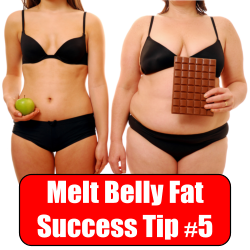How to Keep Motivated with Your Belly Fat Loss Plan
With a new year comes new resolutions and if you’re like many people, one of your New Year resolutions could be to start a belly fat loss plan. But statistically, like most people having the same resolution, you have already broken it by now.
The number one reason people fail to keep their resolutions is a lack of motivation. We need something to keep us focused on our goal.
People are motivated by different things. Here is a list of the top 6 things that work to keep your motivation up:
1.) Set Realistic Goals for Your Belly Fat Loss Plan
Goals have to be realistic and attainable for them to keep you motivated. So before you write down your goal, ask yourself if it is doable. If not, you are setting yourself up for failure. It does no good to have a goal of losing 10 inches off your girth in two months – it ain’t gunna happen, it isn’t realistic and it certainly is not attainable.
2.) Keep a Journal of Your Belly Fat Loss Plan
Now that we have a realistic and attainable goal, writing it down and posting it where you can see it keeps you more accountable to yourself than just saying it. Also through journalism, your fears, frustrations and successes flow out through your pen or keyboard.
3.) Monitor Your Progress of Your Belly Fat Loss Plan
To know if you are making progress or not, you have to have a starting point. Measure your waist before you begin your belly fat loss program. Once a week take a reading at the same place on your waist and record the results in your journal. Don’t forget to write something about how you feel with that number.
4.) Pace Yourself on Your Belly Fat Loss Plan
One of two things that help you lose belly fat is exercising, especially cardio training. The other is food and portion choices. But if you have not exercised in a while, doing a high intensity routine for an hour will be counterproductive. You will be so sore for the next couple of days, that you won’t be able to exercise – thus defeating your purpose. Instead, take it slow and work up to an hour workout.
5) Mix Up Your Belly Fat Loss Plan
If you do the same cardio routine day after day after … you’ll soon tire of it. Instead, try new things, like cross training. Or sign up for a Pilates class. Frustrated? Try kickboxing or boxing itself. The point is there are so many different ways to exercise. Keep it fresh by occasionally adding in new things.
6.) Make Smart Food Choice on Your Belly Fat Loss Plan
This is where many people go wrong. Clean out your pantry/refrigerator of temptations. Get rid of the food you should not eat. Instead stock fresh fruits, vegetables, whole grains, tuna and walnuts among other “good” foods so that when you do eat, your have nothing but good things to choose from. Another trick is portion control. Instead of a regular size plate, eat from a smaller plate. The smaller amount of food looks like more, thus tricking your brain to think you are full.
You can find more “Belly Fat Success Tips” in our weight loss category found at http://myfitnessnut.com and while you’re they, be sure to subscribe to our monthly fitness newsletter and be kept up to date on the latest developments in the world of health and fitness.









